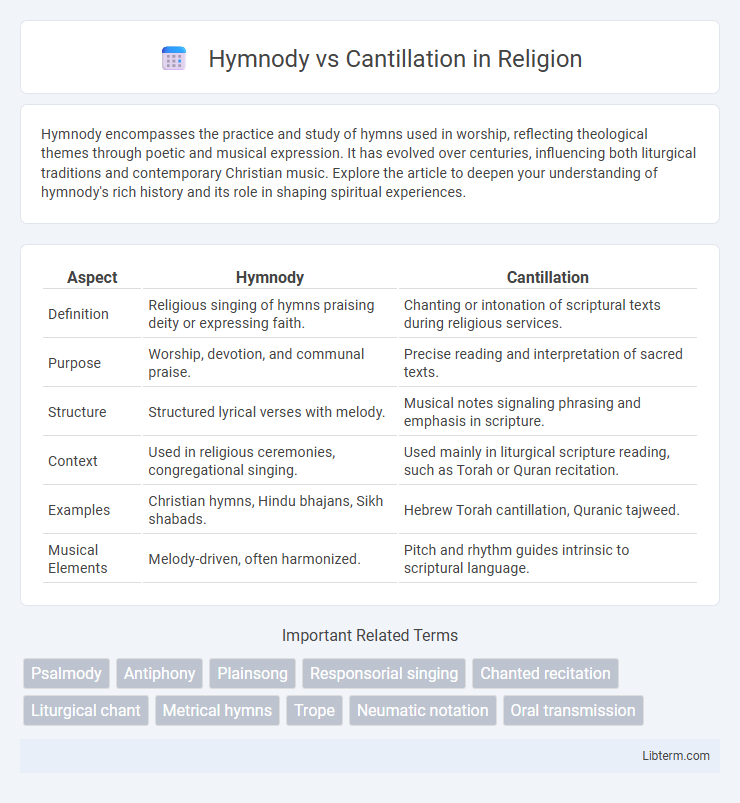Hymnody encompasses the practice and study of hymns used in worship, reflecting theological themes through poetic and musical expression. It has evolved over centuries, influencing both liturgical traditions and contemporary Christian music. Explore the article to deepen your understanding of hymnody's rich history and its role in shaping spiritual experiences.
Table of Comparison
| Aspect | Hymnody | Cantillation |
|---|---|---|
| Definition | Religious singing of hymns praising deity or expressing faith. | Chanting or intonation of scriptural texts during religious services. |
| Purpose | Worship, devotion, and communal praise. | Precise reading and interpretation of sacred texts. |
| Structure | Structured lyrical verses with melody. | Musical notes signaling phrasing and emphasis in scripture. |
| Context | Used in religious ceremonies, congregational singing. | Used mainly in liturgical scripture reading, such as Torah or Quran recitation. |
| Examples | Christian hymns, Hindu bhajans, Sikh shabads. | Hebrew Torah cantillation, Quranic tajweed. |
| Musical Elements | Melody-driven, often harmonized. | Pitch and rhythm guides intrinsic to scriptural language. |
Introduction to Hymnody and Cantillation
Hymnody involves the composition and singing of hymns, structured religious songs expressing praise and worship, historically rooted in early Christian liturgical traditions. Cantillation refers to the melodic chanting of sacred texts, primarily used in Jewish and Christian rituals to enhance the recitation of scripture through specific musical motifs. Both practices serve as vital components in worship, with hymnody emphasizing congregational singing and cantillation focusing on the precise intonation of sacred readings.
Historical Origins of Hymnody
Hymnody traces its historical origins to early Christian worship practices in the 2nd and 3rd centuries, characterized by the composition of structured, metrical hymns used in communal praise and liturgy. Influential figures like St. Ambrose of Milan popularized metrical hymnody in the 4th century, establishing a foundation for Western Christian hymn tradition. This development contrasts with cantillation, which primarily stems from ancient Jewish liturgical chant used to vocalize scripture with melodic intonations rather than structured hymnic poetry.
Historical Roots of Cantillation
Cantillation traces its historical roots to ancient Jewish liturgical traditions, where specific melodic motifs were used to chant biblical texts during synagogue services. These melodic patterns served as mnemonic devices, guiding proper pronunciation and interpretation of the Torah, Nevi'im, and Ketuvim. Unlike hymnody, which typically features communal, harmonized singing, cantillation is characterized by precise musical annotations, known as trope marks, that direct the chanting of scripture in a ritual context.
Key Differences Between Hymnody and Cantillation
Hymnody involves the composition and singing of hymns typically characterized by structured poetic verses meant for congregational worship, emphasizing thematic theology and melody. Cantillation refers to the specific chant-like recitation of sacred texts, guided by musical notations that dictate pitch and rhythm to enhance scriptural interpretation. The key difference lies in hymnody's focus on lyrical worship and communal singing, whereas cantillation centers on the precise melodic articulation of religious scriptures during liturgical readings.
Liturgical Functions in Worship
Hymnody serves as a congregational element in worship, emphasizing melodic and poetic expressions that foster communal participation and spiritual reflection. Cantillation functions as a specialized vocal practice primarily for chanting sacred texts, such as the Torah or scriptures, with precise melodic motifs designed to enhance textual understanding and liturgical solemnity. Both forms support worship by structuring ritual moments: hymnody enriches collective devotion, while cantillation ensures the accurate and reverent transmission of sacred writings within liturgical contexts.
Musical Structures and Styles
Hymnody features structured strophic forms with repetitive melodic patterns designed for congregational singing, emphasizing harmony and lyrical clarity. Cantillation employs intricate melodic motifs and ornamental phrases tailored to vocal chanting of scriptural texts, often utilizing modal scales and specific rhythmic formulas. These distinct musical structures reflect differing liturgical functions, where hymnody prioritizes communal participation, and cantillation enhances textual interpretation through precise musical enunciation.
Linguistic and Textual Variations
Hymnody and cantillation exhibit distinct linguistic and textual variations, with hymnody often characterized by fixed poetic structures and thematic repetition, reflecting theological concepts in metrical forms. Cantillation involves melodic chanting tied closely to the textual syntax and punctuation of sacred scriptures, using specific musical motifs to guide pronunciation and interpretation. These differences highlight how hymnody emphasizes lyrical composition, while cantillation prioritizes precise verbal delivery and textual exegesis.
Cultural and Religious Significance
Hymnody encompasses the composition and singing of hymns that play a central role in Christian worship, expressing theological doctrines and communal devotion through structured poetic forms. Cantillation refers to the melodic chanting of sacred texts, primarily in Jewish religious traditions, preserving the precise pronunciation and intonation of scriptures such as the Torah and Haftarah. Both practices serve to deepen spiritual experience and cultural identity, with hymnody emphasizing collective worship and cantillation ensuring scriptural fidelity and oral transmission.
Modern Adaptations and Practices
Modern adaptations of hymnody incorporate contemporary musical styles and digital arrangements, enhancing congregational engagement and accessibility. Cantillation practices have evolved to include multimedia presentations and diverse linguistic elements, preserving traditional chant while appealing to a broader audience. Both forms integrate technology and cultural influences to maintain relevance in modern worship settings.
Comparative Influence on Contemporary Worship
Hymnody and cantillation both shape contemporary worship but with distinct influences; hymnody emphasizes structured lyrical compositions that foster congregational singing and theological reflection, while cantillation centers on melodic chanting rooted in scriptural recitation that enhances liturgical solemnity and spiritual immersion. The integration of hymnody often leads to more accessible and emotionally resonant worship experiences, promoting community participation, whereas cantillation preserves ancient traditions and nuanced vocal expressions that deepen scriptural engagement. Worship leaders increasingly blend these elements to create balanced services that honor historical practices while encouraging active congregational involvement.
Hymnody Infographic

 libterm.com
libterm.com